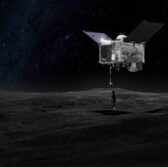 NASA launched a Lockheed Martin-built spacecraft Thursday from Cape Canaveral Air Force Station in Florida aboard a United Launch Alliance rocket on a mission to explore and collect a sample from the near-Earth asteroid Bennu.
NASA launched a Lockheed Martin-built spacecraft Thursday from Cape Canaveral Air Force Station in Florida aboard a United Launch Alliance rocket on a mission to explore and collect a sample from the near-Earth asteroid Bennu.
Lockheed said Wednesday the Origins, Spectral Interpretation, Resource Identification, Security-Regolith Explorer spacecraft separated from the Atlas V 411 rocket nearly an hour after launch, then autonomously deployed a pair of solar arrays and turned on the vehicle’s telecommunications radio.
Rich Kuhns, manager of the OSIRIS-REx program at Lockheed’s space systems segment, said initial data collected from the spacecraft showed its systems have performed smoothly in the initial minutes of the mission and that the spacecraft is on its proper trajectory.
NASA expects OSIRIS-REx to reach Bennu sometime in 2018 and bring at least 2.1 ounces of surface material back to Earth in 2023 for extensive analysis by researchers.
Lockheed said the asteroid sampling mission will help scientists to gain insight into the earliest stages of the solar system’s formation.
The agency gave the green light to the OSIRIS mission Wednesday, just a day after the spacecraft completed a launch readiness evaluation.




